Abstract
Poster Design
Typography
Character Design
Graphic Design
App Design
Game Design
Interactive Design
Enviromental Design
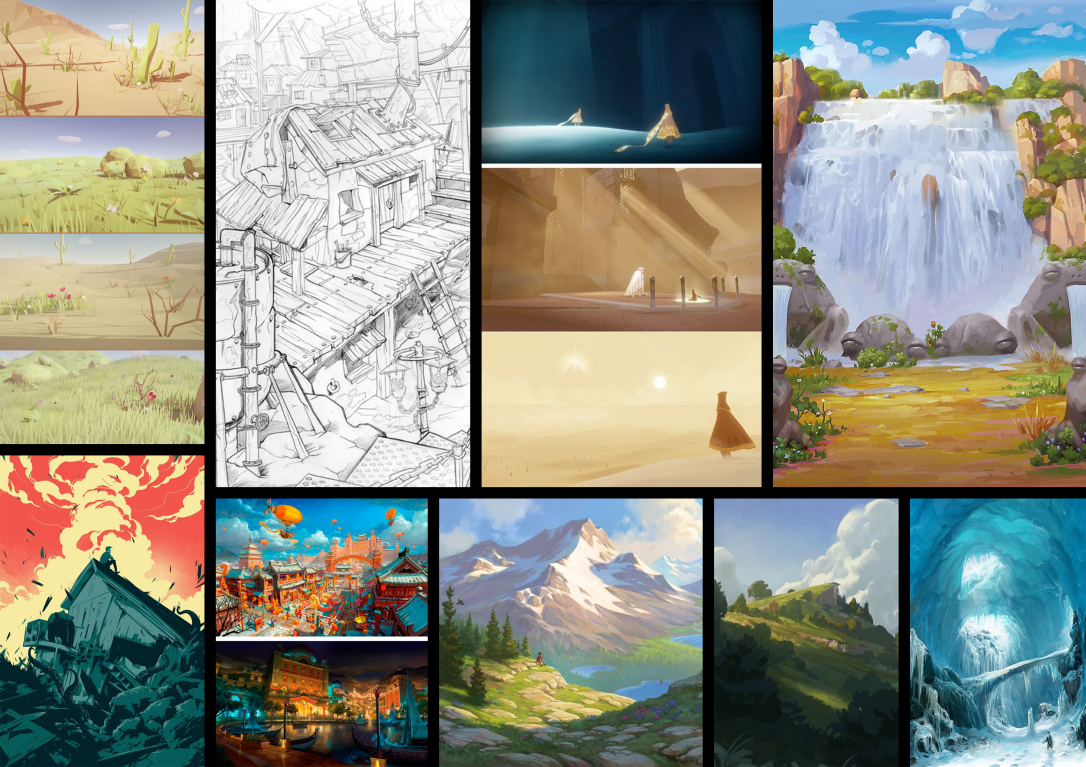

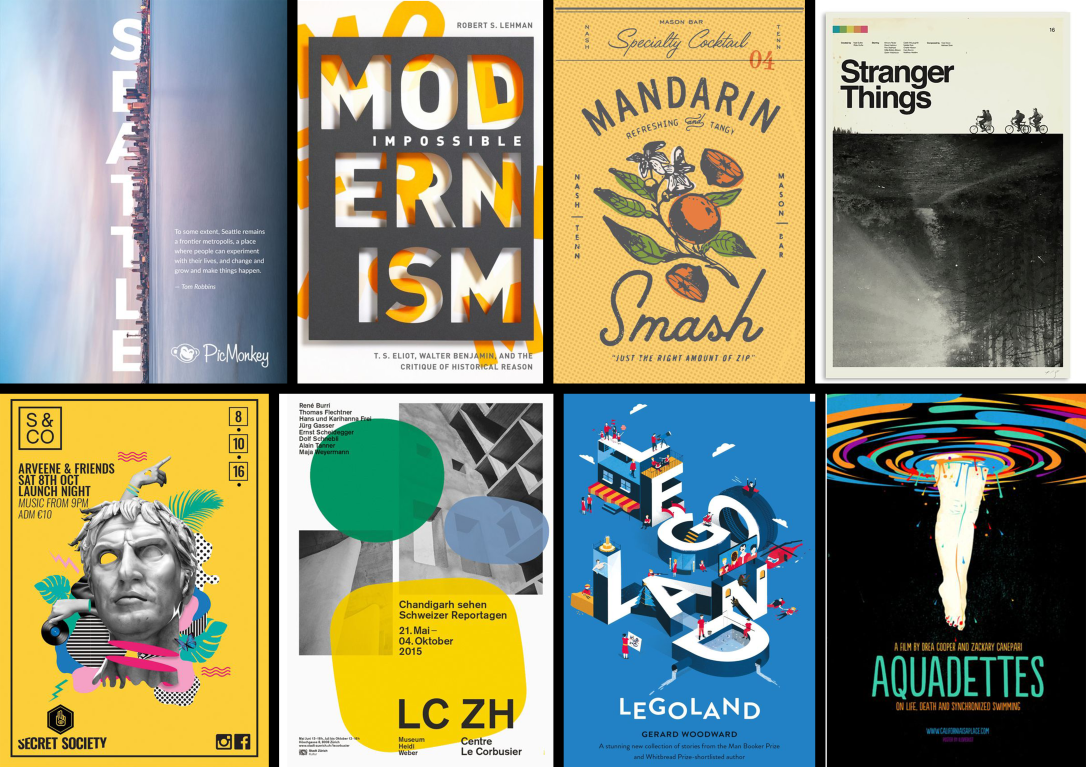


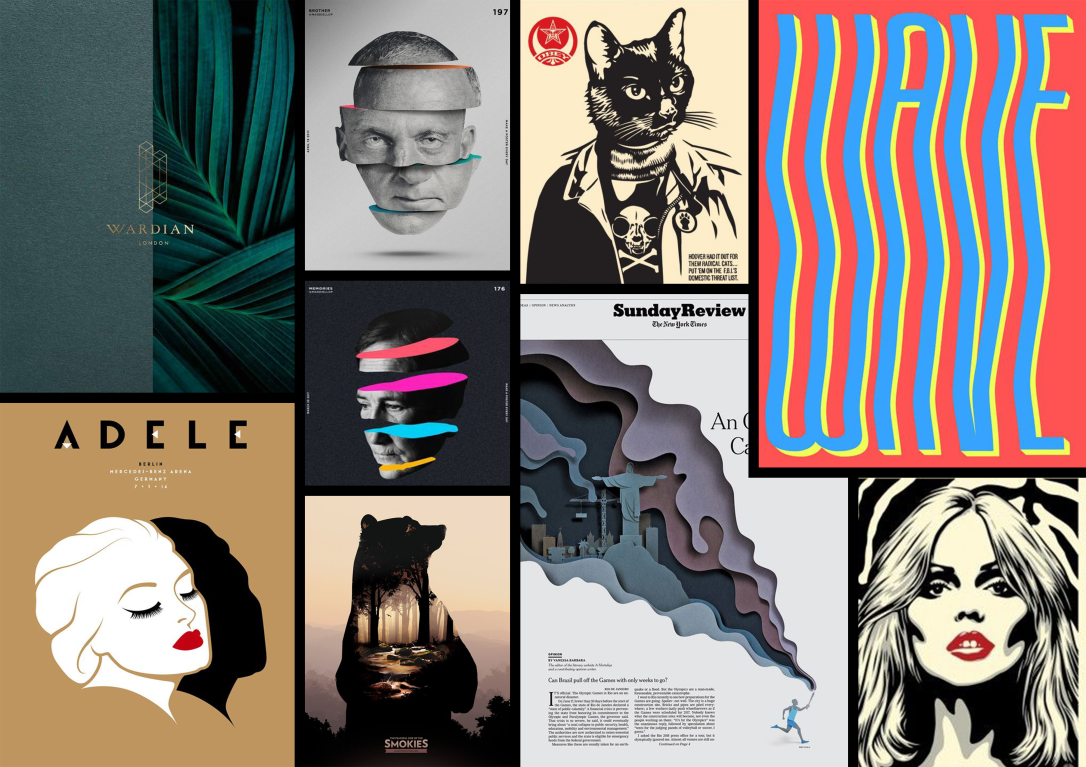

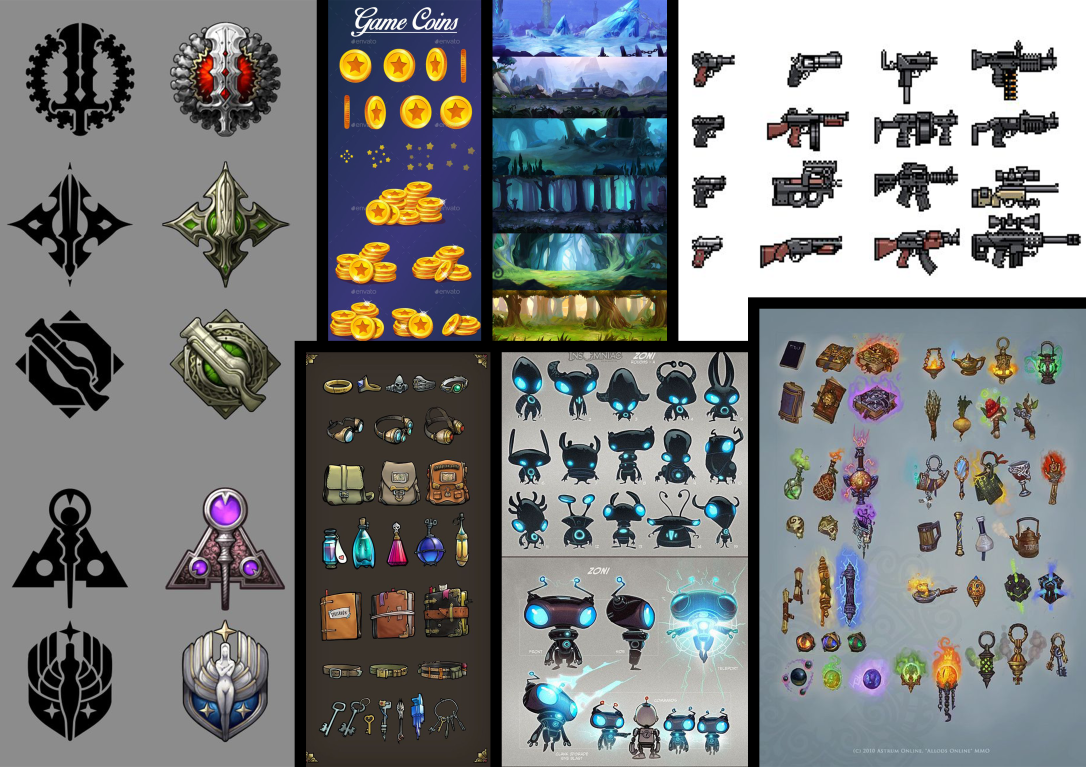
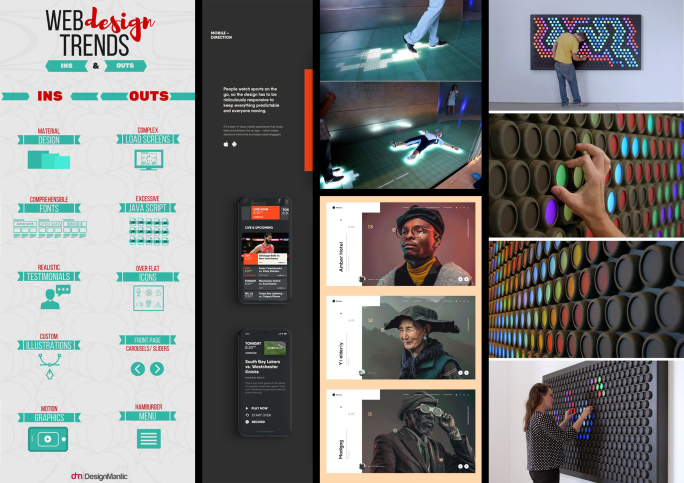

We went on a trip to the Tate Modern museum to gather pictures and info of famous artworks and replicate them in our sketchbooks to gain a better understanding of using materials.
This first piece is literally called “Untitled (For Francis)” which was originally a plaster mould of the artist himself. I feel like I got the shape of the sculpture pretty spot on along with the lines and holes on the sculpt. I would have liked to try and colour in the sculpt black but I fear I would ruin it if I tried.

Next is “monsieur plume with creases in his trousers” originally by Jean Dubuffet. I personally am quite a fan of this art piece as it really goes beyond exaggeration and overemphasises its features. As for the recreation I did, it’s not as good as the original but I find its a good replica. I do like the pencil strokes I used to create the piece as I think it represents Jeans style pretty well.
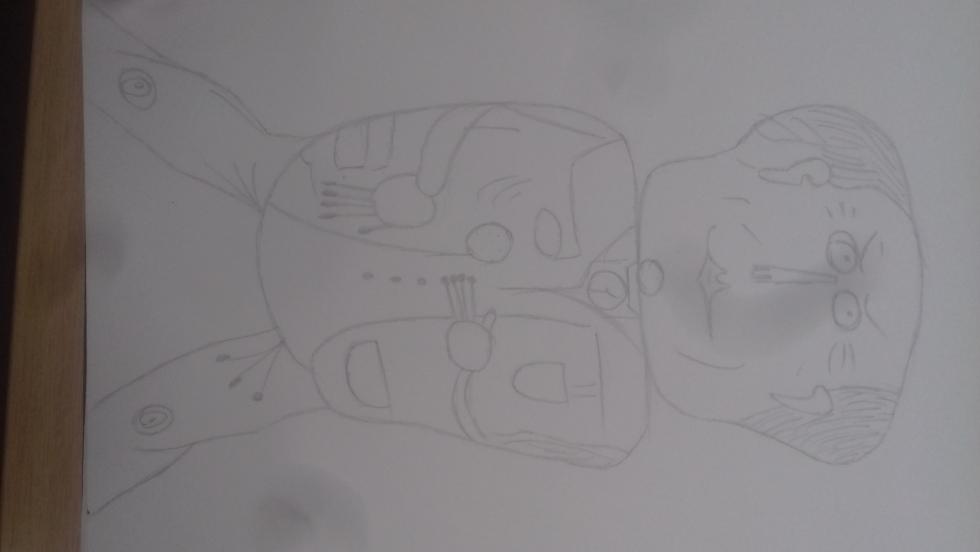
This is Rothco’s “White Centre” recreated by me. The original piece isn’t so much about appearance but more emotion and what you’re meant to feel. The recreation I find is quite accurate in terms of design but I think the colours are a little off, some seem too vibrant than the original. Either way, I don’t think it looks terrible, though I would have liked to improve upon the strokes of the paint as they look rough.
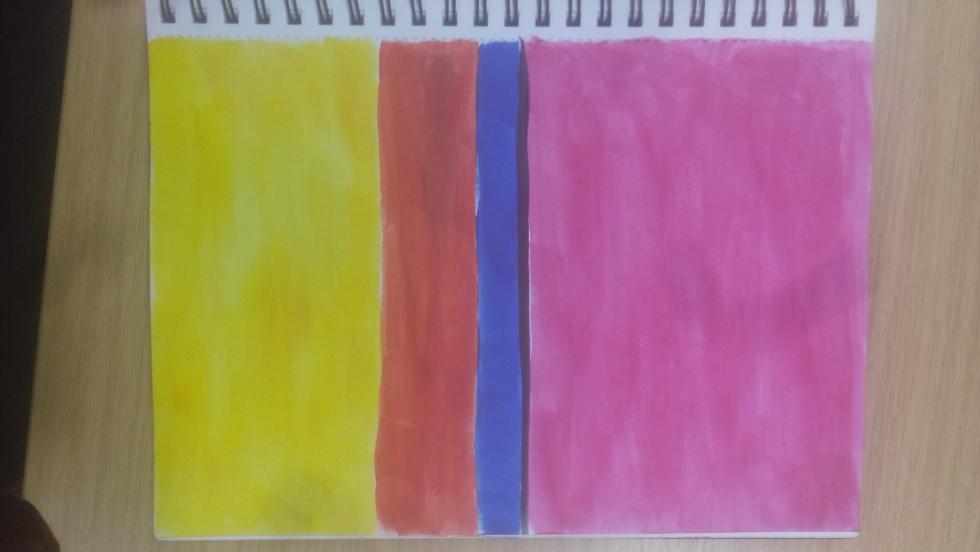
Next up, “Composition C with red yellow and blue” By Piet Mondrian. The same principles follow here from White Centre. The recreation wasn’t very difficult in terms of shape form and colour. The colours on this one are better replicated than White Centre. However, I still think the brush strokes are a problem for me as they aren’t as neat as I would have liked. Nonetheless, I still like the way this turned out.
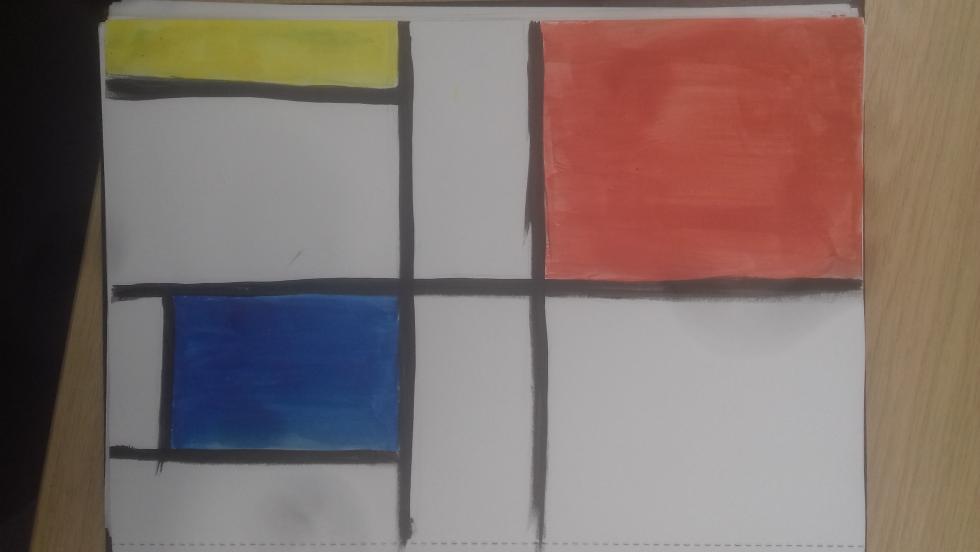
Finally, we have “Ish’s light” by Anish Kapoor. Replicating this was surprisingly quite challenging as I was trying to get the shape from my perspective perfect. I feel like the shading was pretty good though I would have liked to improve on it as I don’t think its smooth enough, you can see the pencil strokes too easily. Though I still think I replicated the tones on the shape.
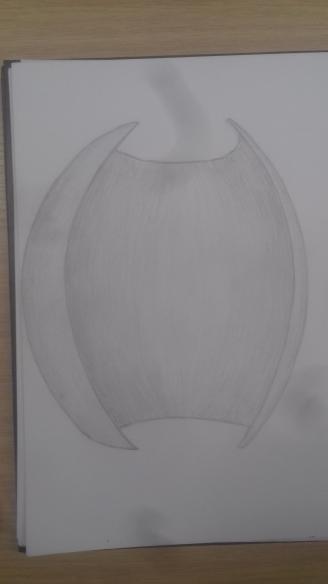
1. What is Christies?
A) Christies is a big show room in London.
2. How much is Mark Rothko’s White Centre?
Over $72,000,000 or $72,840,000 to be precise.
3. Value isn’t always connected to what?
It isn’t always connected to Quality.
4. What does provenance mean?
Provenance is something that can increase the value of a painting.
5. Who previously owned Rothko’s White Centre?
The Rockefeller’s.
6. How did they earn their wealth?
They gained their wealth from oil and banking, whilst also creating the Rockefeller centre.
7. 1n 1960 how much did he pay for White Centre?
Less than $10,000.
8. Who are the current owners?
The current owners are unknown since the auction.
9. Massacre of the Innocents by Peter Paul Rubens is worth what?
$76,529,058.
10. Where are the majority of old master paintings?
In museums.
11. How did Ken Thomson earn his wealth?
He built a global media company that is mentioned in the times as well as the Sunday times
12. How much did he pay for Massacre of the Innocents by Peter Paul Rubens?
He paid $49,000,000 for the painting which is currently $76,000,000
13. What number on the rich list of people in Britain is Jeffrey Archer?
583rd richest person
14. How much is Monet Water Lily Pond worth?
$80,379,591
15. How many years did Monet spend painting this water lily pond
26 years
16. What is the most popular postcard sold in the National Gallery?
A vase filled with sunflowers that were produced by van gough
17. How much did Au Moulin de la Galette by Renoir sell for?
$78,100,00
18. How much did Portrait of Dr Gachet by Van Gogh sell for?
$82,500,000
19. Who bought them?
No one know Ryoel Saito had bought art places from Van Gough and renoir as he kept hidden even from his family.
20. What is rumoured to have happened to the painting ‘Portrait of Dr Gachet’ by Van Gogh owned by Japanese businessman, Ryoei Saito?
People speculated that he burned the piece with him to the grave.
21. How much was Francis Bacon Triptych sold for?
$86,281,000
22. Who bought it?
Roman Abramovich
23. Adele Bloch-Bauer II (2) by Gustav Klimt was sold for?
$87,936,000
24. What is restitution art?
When an artist’s artwork is sold off and then returned to the original creator of the artwork
25. Dora Maar Au Chat by Picasso sold for?
$95,216,000
26. How old was Picasso when he painted boy with a pipe?
24
27. How much did it sell for?
$104,168,000
28. What did Steve Wynn do to his Picasso painting, Le Rêve?
Upon soon selling the piece, he accidentally put his elbow through the painting, reducing its value and calling off the auction.
29. How many items did Victor and Sally Ganz sell at their auction?
29
30. What did Victor Ganz do for a living?
He was a jewellery businessman
31. How much did Nude, Green Leaves and Bust by Picasso sell for?
$106,482,500 also the worlds most expensive painting.
32. Who is standing next to the painting below?
The Doug Lord 8^)
33. How old was Picasso when he painted it?
87
The start of British Modern Art started where?
British Modern art came of age in Cornwall.
What did one critic describe Patrick Heron’s work as?
Patrick Heron’s work was criticised as an absurd piece. However, the narrator presumes that Heron was ahead of his time.
What did Patrick Heron think art should do?
Heron always thought that art should lift the hopes of other people’s spirits / lift the people’s spirits.
What did Francis Bacon think life was full of?
On the other hand, Bacon thought that life was filled with pain and suffering which is considered to be negative.
What did Francis Bacon’s artwork deliberately set out to do?
Francis’ artwork displayed a surprise for the people with a post-war Britain to the extreme and he did this on purpose.
What did Peter Blake’s work celebrate?
Peter celebrated the Americana at Denim and Elvis.
Who is the father of British Pop Art?
Richard Hamilton
What does Transient mean?
Richard describes pop art transient which the word means only temporarily and that it was not going to last long.
What happened to the UK economy during the 1970s?
In the 1970s, the UK struggled with the economy with the working state with the employee, multiple strike and bombing.
Gilbert and George describe themselves as?
In 1967, Gilbert and George both decided to look into the respective side of England rather than the rebellious side. On the other hand, their art was unconventional and cheeky.
What was the new spirit for 80’s Britain?
Punk
Who is the world’s richest living artist today?
Damien Hirst
Who is Charles Saatchi?
Charles Saatchi, an Iraqi and British, is a businessman who works for Saatchi and Saatchi alongside with his brother, Maurice.
At the end of the 80’s boom, how much did Hirst sell his work at Sotheby’s auction for?
95 million pounds
What was Tracy Emin’s unique selling point?
Tracy
What does Grayson Perry explore in his work?
Creating chaos that would violate social media
What does he feel the main most important activity in life is?
Careless shopping
What is the meaning of the following terms
Rationing: Balancing out to the amount of consumer with the resources.
Stiff upper lip: To maintain a certain type of expression or emotion. To show composure in all situation.
Abstract art: Artist uses abstract art to produce shapes, patterns, and colours to convey their emotions as this form of art is known for being expressive.
Postwar Britain: After the war, this term would often describe what has happened after this tragic incident.
Triptych: On the three panels, it shows a sense of relief.
Art deco is a form of visual arts-based off of architecture, painting, sculpture, graphics and decorative arts. This art movement started to rise during World War 1. The main concept of this style uses the clean shaped and simple streamlined look that is usually geometric and stylised. These also include man-made substances like plastic. It originated in 1908 and after some time and died off in 1935.

George Barbier (1882-1932) was one of the key artists of the “Art Deco” movement and one of the most prestigious French artist’s and fashion illustrators to emerge from post World War 1 in the early twentieth century. Born in 1882 he became widely acclaimed for the design of costumes, jewellery, wallpapers and more. His work with various magazines such as Vogue cemented his reputation as a leading design artist. Little is known of Barbier’s personal life, but it is known that he attended the Ecole des Beaux-Arts in the atelier of Jean-Paul Laurens in 1907.
Barbier is often inspired by the patterns that are on a vase and includes similar patterns to his pieces. He tends to include people in his work, whilst also including patterns flowing naturally in the piece. It is often known best for its exotic attire and artistic outlines.
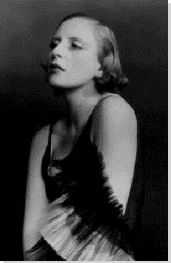
Lempicka was a traditional easel artist who got her style from Italian Renaissance paintings. Tamara de Lempicka was renowned for both her own beauty and her ability to create beauty. The painter captured the sensuality and stylised quality of the Art Deco movement. She also embodied the glamour of her era.

Her style incorporates the geometric forms similar to cubism but to others is more seen as Art deco. Her pieces look soft modelled which gives a sensuous effect, I think is a nice touch at it looks semi-realistic and 3D. She also distorts the bodies of the sitters so that they look like elegant art objects.
Expressionist art usually attempts to convey emotion and meaning. Each artist had their own unique way of expressing their emotions in their art. In order to express emotion, the subjects are often distorted or exaggerated. At the same time, colours are often vivid and shocking. The Expressionist movement occurred during the early part of the 1900s and started in Germany.

Edvard Munch is best known as being a Norwegian born, expressionist painter, and printer. In the late 20th century, he played a great role in German expressionism and the art form that later followed, mainly because of the strong mental anguish that was displayed in many of the pieces that he created.

This is the “Scream” which is one of Munch’s famous works. The majority of this image has been distorted to an uncomfortable extent, and this in combination with the screaming face and the red sky conveys fear, anxiety and loneliness. The pastel strokes seem to flow and somehow still make the piece look somewhat natural. As a result, this art style was inspired by his father’s mental illness as Munch wanted to capture the mentality of his pieces.

Paul Klee was born in Switzerland, on December 18, 1879. Klee participated in and was influenced by a range of artistic movements, including surrealism, cubism and expressionism. He taught art in Germany until 1933, when the National Socialists declared his work indecent. The Klee family fled to Switzerland, where Paul Klee died on June 29, 1940.
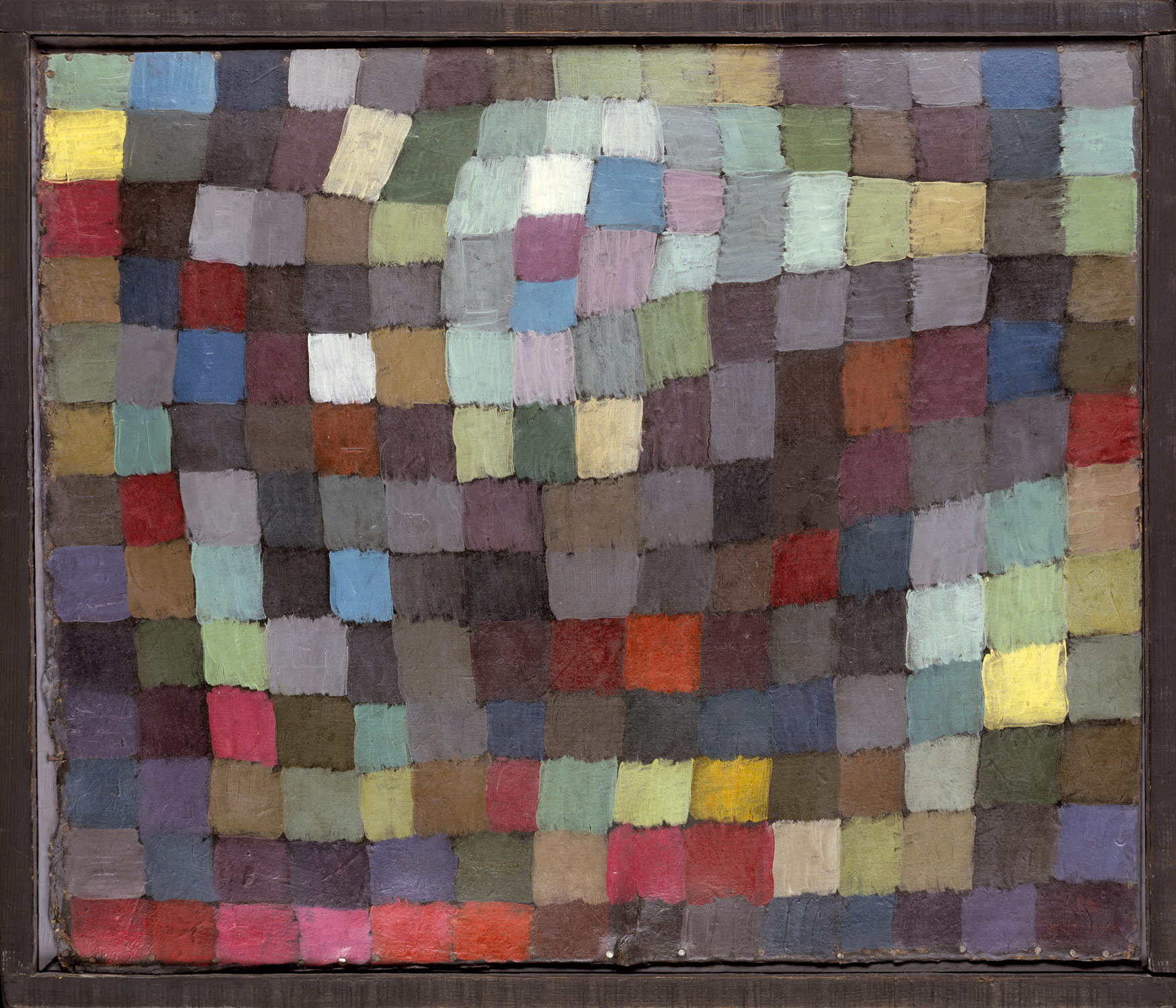
This painting originates from a series klee started based on a visit he made to Tunisia in 1914. The squares on this painting resembles oddly placed stones on a mosaic design. This can also be viewed as a test for colour theory as he uses a variety of colours. To me, this painting is quite appealing to look at because of these factors. Because of the oddly placed squares and their position, it almost looks natural.
Futurism celebrated advanced technology and urban modernity. Its members disliked the older forms of culture and wanted to demonstrate the beauty of modern life, the beauty of the speed, violence and change. Although the movement did foster some architecture, most of its adherents were artists who worked in traditional media such as painting and sculpture, and in an eclectic range of styles inspired by Post-Impressionism. Nevertheless, they were interested in embracing popular media and new technologies to communicate their ideas.
Italian painter, sculptor, and theorist of the Futurist movement in art. Boccioni was supposedly influenced by Cubism in 1911–1912, and during that time he also became interested in sculpture. Boccioni enlisted in the army during World War I and was killed by a fall from a horse in 1916. He was the most talented of the Futurist artists, and his death marked the end of the movement.
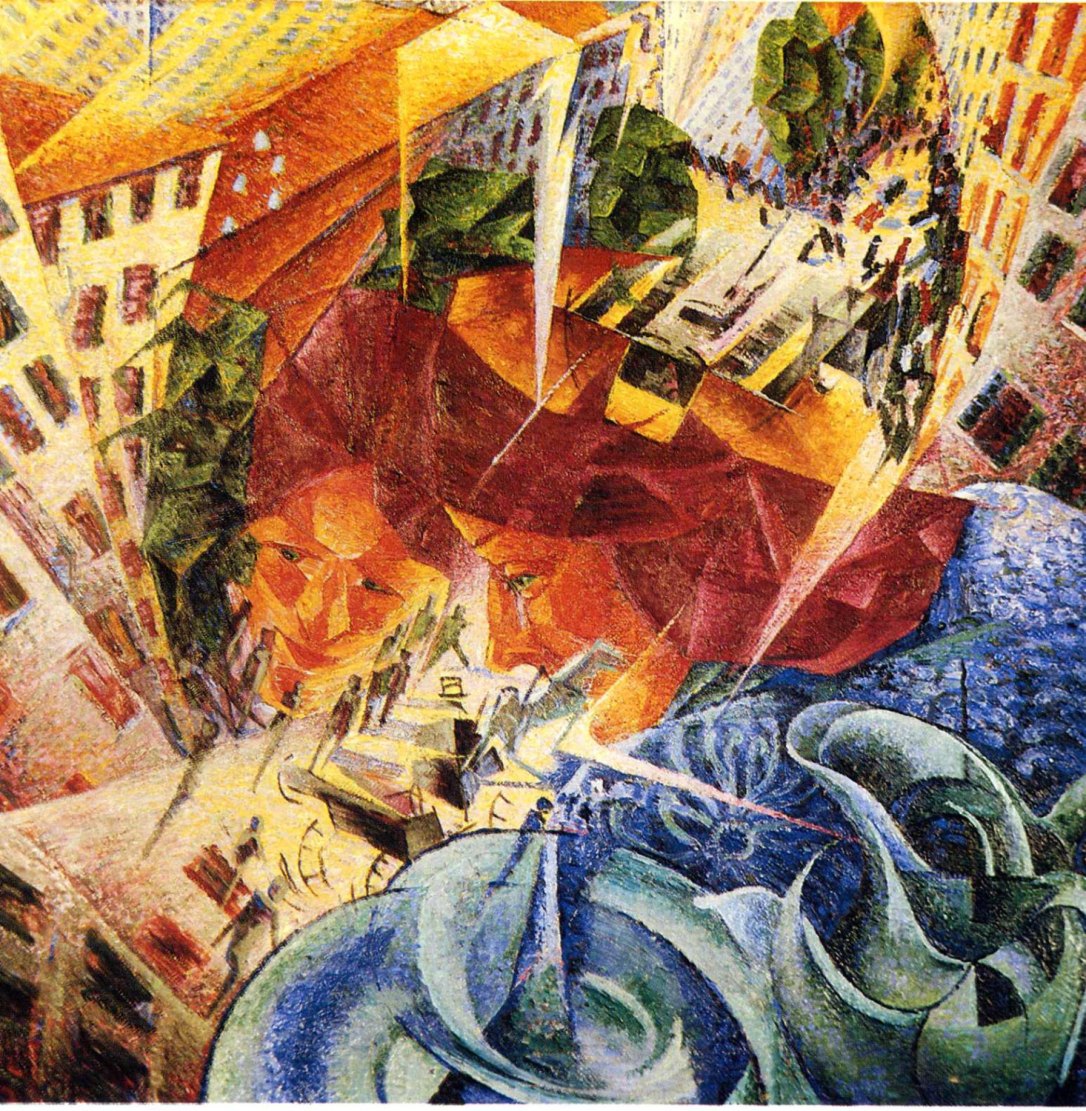
This painting is a visual representation of Boccioni’s view of progression of the world. He used lots of broken panels and slanted buildings to represent to speed and consistency of progression of tech in the world. A feature I like in this painting are the two faces under the tunnel like structure, it almost looks like their existence is holding up that path above them, keeping the area intact. The fact that they’re looking down can also represent the speed of tech. A lot about this piece screams proud futurism. From its bizarre shapes to its flashy colours.

Giacomo Balla was an Italian Futurist artist known for his geometric paintings that depicted light and movement. His work, influenced by Umberto Boccioni and Gino Severini, was inspired by technology and industrialisation. Born on July 18, 1871, in Turin, Italy, he became interested in the arts after working in a lithograph print shop at the age of nine. He later moved to Rome to work as a commercial illustrator, and became interested in painting and became increasingly involved in the Futurist movement.
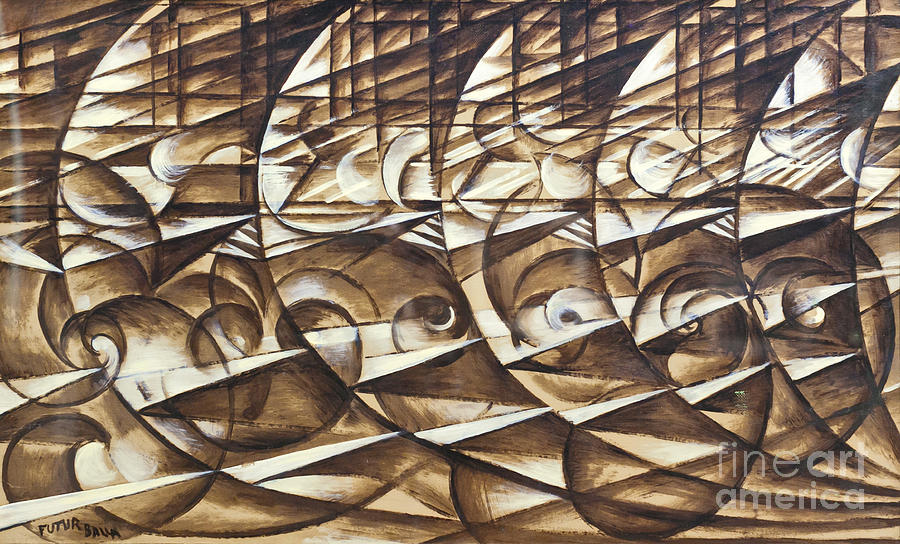
Balla likes to emphasise on the extreme shapes in his pieces to better emphasise the advancement and speed in tech, hence why this painting is called “Expansion And Speed.” I like the use of colour too, it looks near gold which shows the value of futurism and shapes.
This art movement formed during the First World War in Zurich in negative reaction to the horrors of the war. The art, poetry and performance produced by Dada artists are often “bizarre” in nature. The artists felt the war questioned every aspect of a society capable of starting it, including its art. Their aim was to destroy traditional values in art and to create a new art to replace the old.

Tzara is considered the founder of Dada. His primary contribution was publishing manifestos outlining the goals of Dada and circulating them to as wide an audience as he could solicit and arranging vulgar and shocking performances at a local Café featuring deconstructed language and outrageous acts purposefully intended to shock his audience and upset all preconceived expectation. Tzara founded Dada art in Zurich during World War I.

This piece helps express the feelings Tzara had. The fact that a good portion of the words are both bright red and large and scattered can help emphasise the impact of his feelings which could suggest a feeling of either hatred or fear. I also like how some of the words are sorted to fit a grid pattern as if his emotions are mixed between good and bad, making a good contrast.
Cubism was a revolutionary new approach to representing reality invented in around 1907-1908 by artists Pablo Picasso and Georges Braque. They brought different views of subjects (usually objects or figures) together in the same picture, resulting in paintings that appear fragmented and abstracted.

Léger’s work was heavily influenced by his surroundings and his experience of modern life. Though he built his reputation as a Cubist, his style varied between figuration and abstraction and showing influence from a wide range of sources. Léger worked using a variety of media including paint, ceramic, film, theatre and dance sets, glass, print, and book arts. While his style varied, his work was consistently graphic, favouring primary colours, pattern, and bold form.

This oil painting named “Propellers” was made using a mix of cubism and Purism, which is a more refined version of cubism which uses thick machine like lines instead of exaggerated shapes. Léger was the first to attempt this. The overlaying shapes are a good way of confusing the viewer as this is an observational painting, exaggerated. A thing I like about this painting is the layout. Everything is placed oddly to a point where it seems comfortable and natural.
Surrealism aimed to revolutionise human experience, rejecting a rational vision of life in favour of one that asserted the value of the unconscious and dreams. The movement’s poets and artists found magic and strange beauty in the unexpected and the uncanny, the disregarded and the unconventional. Its style often features unnatural object in combination with natural to create an unusual look. It is called surrealism as the word surrealist means “out of this world.”

Magritte aimed to cultivate an approach that avoided the stylistic distractions of most modern painting. While some French Surrealists experimented with new techniques, Magritte settled on a technique that clearly articulated the content of his pictures. In a good amount of his paintings, he tends to use repetition for it is a sign of trauma. But his work in commercial art may have also played a role in prompting him to question the conventional modernist belief in the unique, original work of art.
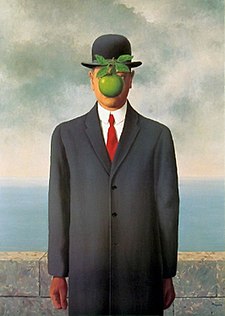
This originally started out as a commissioned oil painting for a friend of Magritte’s. Magritte found it difficult to paint his own face and as a result, he covered his face in the painting with an apple. At first the painting may seem simple but in fact, it is uncomfortable. The give away is the apple blocking the face of Magritte as that alone is unnatural. His clothing is also rather odd in an environment like this as he seems out of place. And to further emphasise the uncomfortable nature, his pose is stiff and dull almost representing a depressing emotion. These clever details are what makes me like this piece.
Modernism refers to a global movement in society and culture that from the early decades of the twentieth century which sought a new alignment with the experience and values of modern industrial life. Building on late nineteenth-century precedents, artists around the world used new imagery, materials and techniques to create artworks that they felt better reflected the realities and hopes of modern societies.
Leonardo da Vinci was a painter, sculptor, architect, inventor, military engineer and draftsman. With a curious mind and keen intellect, da Vinci studied the laws of science and nature, which greatly informed his work. His ideas and body of work have influenced countless artists and made da Vinci a leading light of the Italian Renaissance. Due to this, his work was very diverse as he had other interests. With his portraits, he tends to go critical with measurements to ensure an accurate representation of the figure.

This is a painting of Jesus, yet the painting is named Salvator Mundi as Jesus is referencing him. Da Vinci’s style is very iconic and recognisable and can be seen here as he focuses more on the smaller details of a portrait. For example, he puts emphasis on the creases of the coat and the hair on Jesus as they appear more detailed and clearer than the face, not to mention the background is almost solid black which is another indicator of Da Vinci’s style.
Pop art started with the New York artists Andy Warhol, Roy Lichtenstein, James Rosenquist, and Claes Oldenburg, all of whom drew on popular imagery and were actually part of an international phenomenon. Pop artists celebrated commonplace objects and people of everyday life, in this way seeking to elevate popular culture to the level of fine art. Pop art has become one of the most recognisable styles of modern art. The style persists of bright flashy colours with a cartoony finish and occasional patterns that often have meaning.
Patrick Caulfield was an English painter and printmaker associated with the Pop Art movement, known for bold images created in a strikingly graphic style. Including references to Photorealism, his paintings are characterized by their flat planes of colour and cartoonish black outlines, creating an uncomfortable correlation between the real and the illusionary.

A good example of mixing real and illusionary can be seen in this piece, most noticeably with the painting in the room. It’s an attempt to confuse the viewer into thinking its a window looking outside when it’s really just a painting. Often, Caulfield printmakes with his pieces resulting in his colours being solid. Personally, this piece doesn’t interest me as much as it seems to lack in my opinion in terms of colour, despite how it may be to convey the man’s feelings in the piece, which I think is a clever addition. I do like the detail into the objects however as they look accurate.
Postmodernism can be seen as a reaction against the ideas and values of modernism, as well as a description of the period that followed modernism’s dominance in cultural theory and practice in the early and middle decades of the twentieth century. The term is associated with scepticism, irony and critiques of the concepts of universal truths and objective reality.
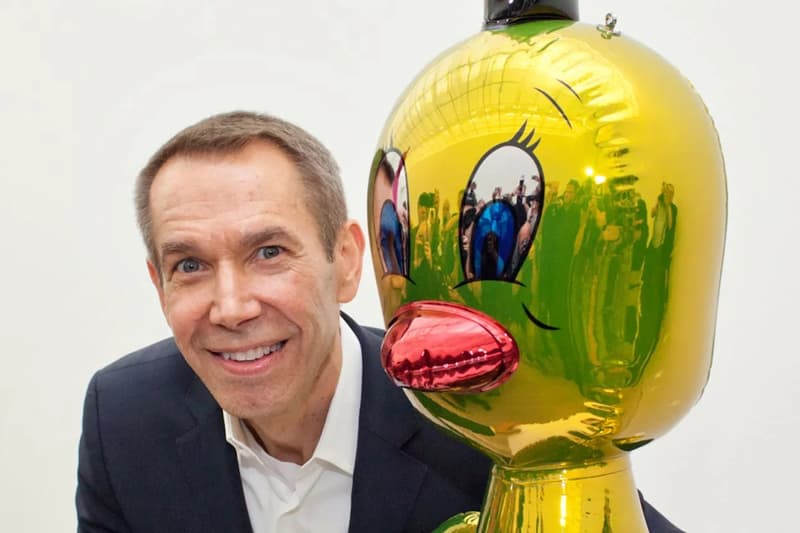
He is known for his exquisitely crafted paintings and sculptures reproducing objects using materials and ideas from popular culture to make his art. His most noticeable pieces of work are the “puppy” and “balloon dog”. Jeff Koons rose to prominence in the mid-1980s as part of a generation of artists who explored the meaning of art in a media-saturated era. He gained recognition in the 1980s and set up a factory-like studio in New York.

This is one of Koon’s most famous sculptures. It uses mirrored-stainless steel with a blue coat giving it the illusion that it’s an actual scaled up balloon dog which is a look I really find satisfying to look at. This is one of the 5 he has done in his balloon series. A thing he also did was that he Combined Pop art with craft-making and popular culture to create his own unique piece.
Originated by The label Young British Artists (YBAs) which is applied to a loose group of British artists who began to exhibit together in 1988 and they became known for their openness to materials and processes, shock tactics and entrepreneurial attitude
Sarah Lucas started her career in 1988 as part of the rebellious “Young British Artists”. She is part of the generation who emerged during the 1990s. Her work tends to frequently include visual puns and humour, and include photography, collage and found objects. Together with her colleagues Damien Hirst, Tracy Emin and others, she roiled the London art scene with her outstanding pieces.

Looking at a piece like this makes you think of a lot of things both questionable and uncomfortable. It is made from tights stuffed with pale-coloured fluff and twisted into a bizarre form, resting on top of a set of stacked blocks. This gives me the thought of it being a fleshy body part and kind of resembles a set of body parts on a butcher’s block. The skin colour helps to emphasise this. the fact that it is tangled up like that shows complexity, possibly referring to how complicated the human body is. Its a rather simple piece but it can have many meanings.